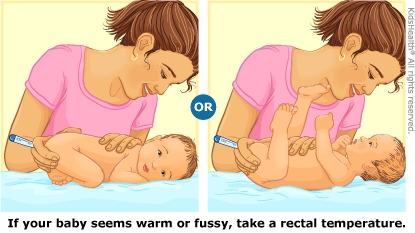Fever: How to Care for Your Child, Age 22–60 Days
In babies, a temperature of 100.4°F (38°C) or higher when measured in the rectum (bottom) is considered a fever. Most fevers don't have a serious cause. But the health care provider checked your baby carefully and did some tests to be sure. Your baby looks well and early test results look OK. You can care for your baby at home while watching for any changes in how your baby is doing.


-
Take your baby to a health care provider within 24 hours (or according to instructions you were given) to make sure your baby is still well and to review any updated test results.
-
Stay reachable by phone so that the hospital can notify you of test results. Sometimes babies need to go back for more or repeat testing.
-
If your baby feels warm or seems uncomfortable, take a rectal temperature using a digital thermometer. Do not use a mercury thermometer, as these aren't safe.
-
If your baby has a fever and seems uncomfortable, medicine may help. Ask your health care provider if it is OK to give acetaminophen (such as Tylenol® or a store brand). Do not give ibuprofen (such as Advil®, Motrin®, or a store brand) to babies under 6 months old. Do not give aspirin to children of any age, as it has been linked to a rare but serious illness called Reye syndrome.
-
Offer your baby breast milk or formula often to help prevent dehydration. Do not offer plain water. It doesn't provide the calories and electrolytes your baby needs.
-
Dress your baby in lightweight clothing. Too many layers could make your baby too warm.
-
Do not put cool water on your baby to lower a fever. You can clean your baby with lukewarm water when needed.

Your baby:
-
isn't able to feed well
-
has vomiting or diarrhea
-
develops a rash
-
is fussy, cranky, or crying and can't be calmed down
-
has a temperature below 97°F (36.1°C)
-
has a fever for more than 2–3 days, or has a fever that returns after having gone away for a while

Your baby:
-
appears dehydrated; signs include drowsiness, a dry or sticky mouth, sunken eyes or soft spot on the head, no wet diaper in 6–8 hours, crying with few or no tears
-
has trouble breathing
-
has a bulging soft spot on the head
-
has a seizure (body movements that look uncontrolled)
-
seems to be getting sicker

What causes a fever? In most cases, a fever in a baby is due to a viral infection (such as a common cold). But some fevers are caused by bacterial infections, which can be very serious in babies younger than 2 months old.
What tests might health care providers do for babies with a fever? Besides doing an exam, a health care provider might order some of these tests:
Some test results are ready on the same day. Others take a few days.
Why does a baby with fever need so many tests? Health care providers need to test for bacterial infections in young babies with fever because:
-
A baby’s immune system (which fights infection) is not fully developed. So they can’t fight infections as well as older kids and are more at risk for a serious bacterial infection.
-
Babies can't tell us how they feel or where it hurts. Without testing, it’s hard to know whether a baby’s fever is from a mild viral infection that will get better on its own or a serious bacterial infection that needs special treatment.
What's the best way to take a baby's temperature? The best way to measure temperature in most babies is by taking a rectal temperature (in the baby's bottom) with a digital thermometer.